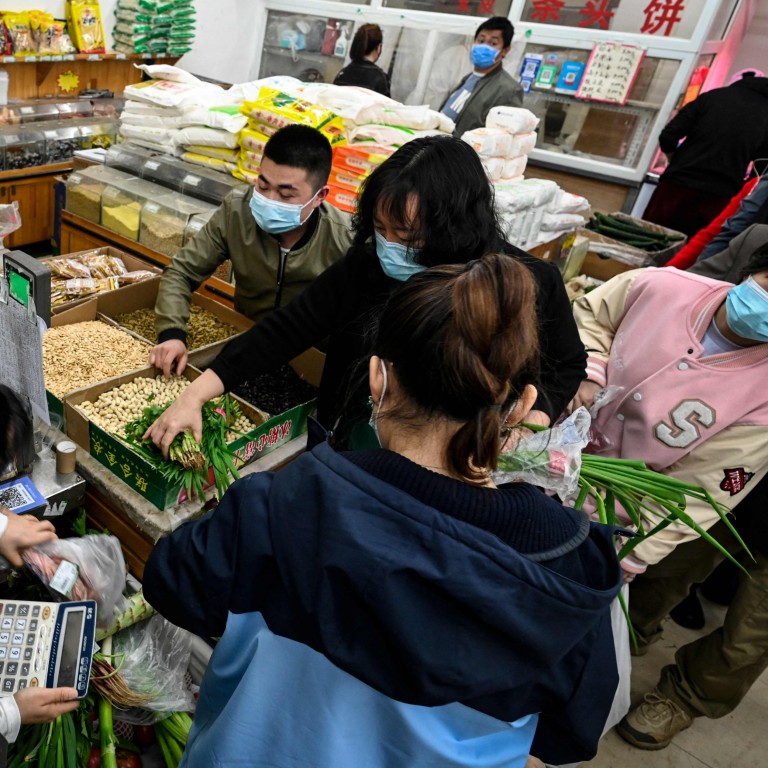
China’s economic risks ‘tilted to downside’, coronavirus-induced contraction ‘most severe’ since 2020 outbreak
- Industrial production fell by 2.9 per cent from a year earlier in April, while retail sales fell by 11.1 per cent last month
- Fixed-asset investment rose by 6.8 per cent in the January-April period, while the surveyed jobless rate rose to 6.1 per cent last month
Calls for a fine-tuning of China’s coronavirus policies and increased stimulus have grown louder after headline data showed China’s economy shrank dramatically in April, with analysts warning the decline has yet to bottom out.
Major indicators measuring the state of the world’s second largest economy fell short of expectations in data released on Monday, with industrial production, retail sales, fixed-asset investment and the surveyed jobless rate falling to their weakest levels in more than two years.
“China’s economic activity contracted in April and was the most severe since the first quarter of 2020 during the first wave of the Covid outbreak,” said Tommy Wu, lead China economist at Oxford Economics, who expects a contraction in the second quarter before returning to growth in the second half of the year.
“The risks to the outlook are tilted to the downside, as the effectiveness of policy stimulus will largely depend on the scale of future Covid outbreaks and lockdowns.”
China is battling its worst coronavirus outbreaks in more than two years, with the lockdowns of both Shanghai and Beijing particularly damaging ahead of the Communist Party’s politically crucial 20th national congress in the autumn.
Industrial production, a gauge of activity in the manufacturing, mining and utilities sectors, fell by 2.9 per cent in April from the previous year, the National Bureau of Statistics (NBS) confirmed.
The various restrictions across the country have also continued to hit consumption, with retail sales dropping to the lowest since a 15.8 per cent drop in March 2020 after April’s reading fell by 11.1 per cent.
Fixed-asset investment, a gauge of expenditure on items including infrastructure, property, machinery and equipment, rose by 6.8 per cent in the first four months of 2021 from the previous year.
But investment in April declined by 0.82 per cent from the previous month after seasonal adjustments, representing the worst reading and the first fall since the indicator dropped by 20.86 per cent in 2020 February.
The surveyed jobless rate, an imperfect measurement of unemployment in China that does not include figures for the nation’s tens of millions of migrant workers, rose to 6.1 per cent in April, which is the second highest reading on record only behind 6.2 per cent in February 2020.
The headline figures mean that China’s gross domestic product (GDP) fell by around 3 per cent from a year earlier in April, according to Ding Shuang, chief economist for Greater China and North Asia at Standard Chartered.
The slowdown will continue as production might not begin to recover until the second half of the year if Shanghai can return to normal in late June after authorities on Monday issued a phased plan to gradually end the lockdown from the beginning of next month.
“People have been disappointed many times before, each time the expectation of opening failed in the end, so if the pace of relaxing controls is slower than expected, the odds of negative growth [in the second quarter] will rise,” said Ding.
China is struggling to contain the latest outbreaks while also trying to achieve solid economic growth and stable job creation.
“The outbreaks in April had a great impact on the economy, but the impact was short-term and external,” NBS spokesman Fu Linghui said.
The government faces mounting pressure to launch new stimulus to stabilise the economy
Home sales, which were once a major engine driving China’s economic growth, slumped by 46.6 per cent from a year earlier by value April from a 26.2 per cent fall in March, representing the fastest decline since August 2006, according to Post calculations based on NBS data.
China’s central bank cut mortgage rates over the weekend to counter the collapse in the property sector.
“The government faces mounting pressure to launch new stimulus to stabilise the economy,” said Zhang Zhiwei, chief economist at Pinpoint Asset Management.
“Fiscal and monetary policies will likely become more expansionary. The property sector will see more restrictions removed.
“Nonetheless, the effectiveness of these policies depends on how the government will ‘fine-tune’ the zero-tolerance policy against the Omicron crisis.”
‘In the beginning, we were optimistic’: a Beijing lockdown diary
“We expect Beijing to stick to its zero-Covid Strategy while stepping up fiscal support, as monetary transmission channels have failed to perform well,” he said.
Chinese policymakers will tolerate further depreciation of the yuan, while ensuring infrastructure investment and placing a curb on the drag from the property sector, while they are likely to cut borrowing costs even as the US Federal Reserve is raising interest rates, said Ding.
“The Chinese government is aiming to coordinate the Covid controls and society and economic development this year, while given the [April] data, the focus is supposed to be more inclined to economic growth,” Ding added.

